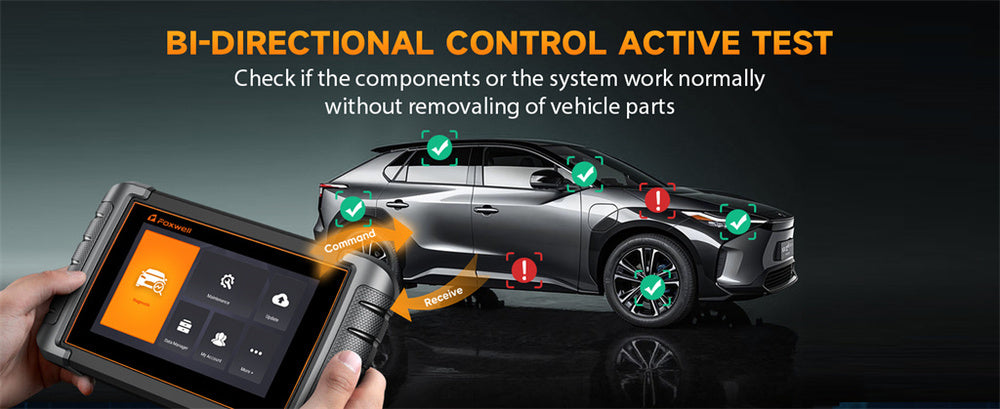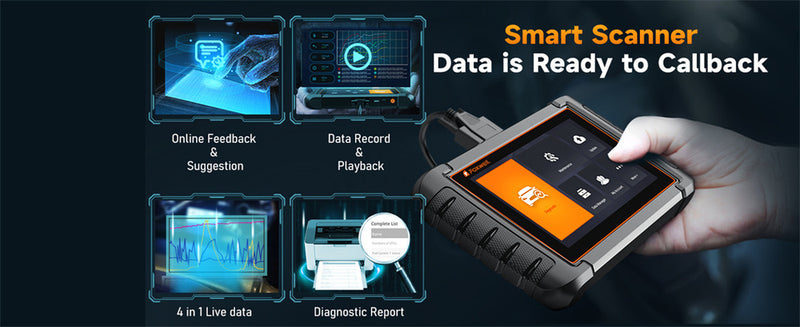Maintaining the health of your vehicle has never been more essential in today's fast-paced environment, and one of the most useful tools available for modern car owners is a wireless car engine diagnostic scanner with Bluetooth capabilities.
These tools allow users to quickly and effectively diagnose issues with their car without visiting the mechanic, saving both time and money by cutting out unnecessary trips to mechanics.

The Rise of Wireless and Bluetooth Technology
The introduction of wireless technology into car diagnostics has revolutionized our approach to vehicle maintenance. Bluetooth diagnostic scanners eliminate cumbersome cables for more flexibility and ease of use; additionally, they connect directly with smartphones or tablets, providing real-time data and diagnostics at your fingertips.
How Wireless Car Engine Diagnostic Scanners Work
Wireless and Bluetooth technology-powered engine diagnostic scanners have revolutionized our approach to vehicle maintenance and diagnostics, especially engine diagnostics. Here's a closer look at their operation as well as their role in engine diagnostics.
The OBD-II Port and Initial Connection
Every modern vehicle comes equipped with an OBD-II (On-Board Diagnostics) port that serves as the gateway for diagnostic tools to connect with their vehicle's Engine Control Unit (ECU). This connection point provides diagnostic data.
Plugging a wireless diagnostic scanner into an OBD-II port immediately initiates communication between it and the ECU, giving access to vital engine performance information like sensor data, error codes and system statuses.
Role of Wireless Technology
One key benefit of wireless diagnostic scanners is eliminating physical cables. Traditional wired scanners require you to be physically attached to the vehicle for use, limiting mobility. Wireless scanners give users more freedom in terms of moving around freely while accessing vehicle data from further away.
Wireless scanners use radio frequency (RF) signals to transfer information between the OBD-II interface and the receiving device (usually a smartphone or tablet), thus creating a continuous and stable stream of information essential for accurate diagnostics.
Bluetooth Technology
Enhances the functionality of wireless diagnostic scanners by providing seamless connectivity with smart devices. Once plugged into an OBD-II port, Bluetooth pairs easily with smartphones or tablets via pairing processes that typically involve selecting your scanner from a list of available Bluetooth devices on your smart device.
As soon as it's connected, a Bluetooth-enabled scanner can relay real-time engine data directly from your engine onto your device - including diagnostic trouble codes (DTCs), live sensor readings, and performance metrics. Bluetooth technology ensures secure and reliable transmission with minimal latency delays.
Benefits of Engine Diagnostics
Real-Time Monitoring: Bluetooth scanners allow real-time updates on engine performance, such as fuel efficiency, air intake and emission levels. This real-time information allows for quicker issue identification as they arise.
Ease of Use: Thanks to their wireless nature, these scanners are extremely user-friendly. You can conduct diagnostics from the comfort of your driver's seat or even outside your vehicle without being constrained by cables.
Accessibility: Bluetooth diagnostic scanners make engine diagnostics accessible to both professionals and DIY enthusiasts by providing user-friendly apps with access to engine data. These apps often include graphing tools, detailed code definitions, and suggested solutions, making the field accessible even to amateur mechanics.
Comprehensive Diagnostics: Wireless scanners can perform a comprehensive engine diagnostic to detect minor issues early and avoid breakdowns and costly repairs.
Enhance Data Analysis: Bluetooth scanner apps offer powerful data analysis tools that can help you gain greater insight into engine performance trends, identify recurring problems and optimize the overall health of your vehicle.
Scenarios for Utilizing Bluetooth Diagnostic Scanners
Bluetooth diagnostic scanners can be an incredibly beneficial resource in various situations, including:
Routine Maintenance Checks: Conduct regular health inspections on your car in order to identify potential problems before they arise.
Before Long Trips: Make sure your car is in excellent condition prior to undertaking long-distance travel.
Check Engine Light: Quickly identify why the check engine light illuminates without visiting a mechanic for diagnosis.
Before purchasing a used car, always evaluate its condition to avoid potential future issues. Performance Monitoring: Staying abreast of your car's performance metrics in real time.
Top Features to Look For
When selecting a wireless car engine diagnostic scanner, keep the following in mind:
Compatibility: Choose a scanner compatible with your vehicle's make and model.
App Support: Look for scanners with reliable apps offering feature-rich solutions.
Data Accuracy: Opt for scanners known for providing accurate and reliable data.
User Interface: For an efficient diagnostic experience, an accessible interface is invaluable. Whilst advanced functions such as live data streaming, freeze frame data collection, and emissions testing may add extra convenience, some scanners offer features to ease your journey to diagnosis further.
How to Use a Wireless Car Engine Diagnostic Scanner
Operating a wireless car engine diagnostic scanner like the Foxwell NT809BT is straightforward and user-friendly, as illustrated here by this step-by-step guide:
Plug the Scanner Into an OBD-II Port
Locate the OBD-II port in your vehicle, usually found under the dashboard near the steering wheel, and use your Foxwell NT809BT or chosen scanner firmly into this port.
Connect to Bluetooth:
- Make sure Bluetooth is enabled on your smartphone or tablet.
- Open the settings menu.
- Locate Foxwell NT809BT from among available devices.
- Pair it.
Follow any prompts to complete the pairing process.
Install the Foxwell NT809BT App Download and install the appropriate Foxwell NT809BT app onto your smart device, opening it and automatically detects your connected scanner; follow any on-screen instructions to establish a connection.
Once connected, use the app's menu to initiate a diagnostic scan for your vehicle. While each app may vary slightly in terms of how it handles this step, typically selecting your make and model before initiating a full system scan is usually the way it goes.
Read Diagnostic Trouble Codes
Once the scan has finished, any Diagnostic Trouble Codes (DTCs) found will be displayed for easy reading. DTCs indicate specific issues or potential problems within your vehicle's systems.
Interpret Data
Use the Foxwell NT809BT app's resources or online databases to decipher trouble codes. With comprehensive descriptions and possible solutions for every code, it is easier than ever before to comprehend and address potential issues.
Take Action
Based on your diagnostic results, you can decide whether or not to tackle issues on your own or seek professional assistance. With detailed information provided by the Foxwell NT809BT, you can make informed decisions regarding vehicle maintenance and repairs. Common Issues and Troubleshooting Solutions.
While wireless diagnostic scanners tend to be reliable, you could experience some common issues:
Problems With Connection and Device Connectivity: For Bluetooth to work correctly and the scanner to be properly connected.
For Inaccurate Data: Check that both app and scanner firmware updates have been made.
Compatibility Issues: Make sure that your vehicle is compatible with this scanner.
Solving these issues usually entails inspecting connections, upgrading software and verifying compatibility.

Conclusion
Wireless car engine diagnostic scanners equipped with Bluetooth are invaluable tools for any car owner, providing an efficient, cost-effective means of tracking the health of their vehicle. A quality Bluetooth diagnostic scanner could save both time and money, making an investment a worthwhile addition to any automotive toolkit.
By remaining informed and prepared, you can ensure your vehicle remains in top condition, giving you peace of mind on the road.
FAQ
What is a wireless car engine diagnostic scanner?
It's a tool that uses Bluetooth to connect to your vehicle's system, allowing for wireless engine diagnostics and troubleshooting.
How do Bluetooth diagnostic scanners work?
These scanners connect to your vehicle's OBD-II port and transmit data to your smartphone or tablet via a Bluetooth connection.
Are Bluetooth diagnostic scanners compatible with all cars?
Most Bluetooth diagnostic scanners are compatible with vehicles that have an OBD-II port, typically found in cars made after 1996.
You Might Also Like
- The Complete Guide to Using Scan Tools with Misfire Counters
- Master Vehicle Diagnostics with OBD2 Scan Tools for Cars and Trucks
- Tips on Selecting and ECU Programming Scan Tools
- Discover the Features in the Best Car Scanners on the Market
- Troubleshooting Common Issues with Bluetooth Obd2 Scanner for Android





Leave a comment
This site is protected by hCaptcha and the hCaptcha Privacy Policy and Terms of Service apply.